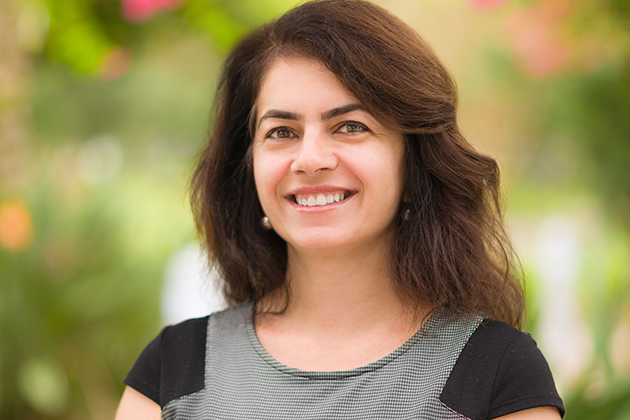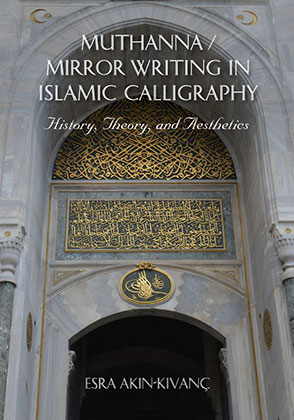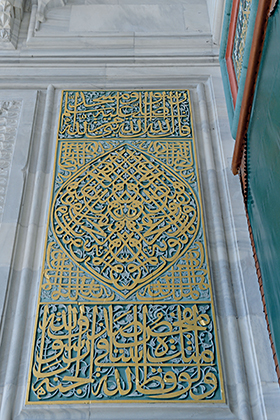USF Art History Professor Esra Akın-Kıvanç Reconstructs History and Meaning of Islamic Mirror Calligraphy
Friday, January 10, 2020
Esra Akın-Kıvanç, USF assistant professor of Islamic art and architecture, is reconstructing
the history of the Islamic mirror calligraphy called muthanna with her upcoming book Muthanna / Mirror Writing in Islamic Calligraphy: History, Theory, and Aesthetics.
With this book, Akın-Kıvanç presents a cross-cultural look at the history muthanna, a new earlier timeline for its prevalence, and a theory of its meaning.
The project began five years ago after Akın-Kıvanç gave a faculty tour of a mosque in Bursa, Turkey, the second capital city of the Ottoman Empire. When she came back to the United States, she continued researching muthanna but discovered a gap in literature.
“I was surprised to find out there was nothing—no book-length study on it,” said Akın-Kıvanç. “So I changed my research trajectory and decided to write a book on this topic.”
What started as an article will now be the first major scholarly contribution on Islamic mirror calligraphy. The book is over five years in the making and involved extensive travel, browsing art collections in the United States, Turkey, England, Egypt, and Canada. Muthanna presents itself on a wide variety of media, including architecture, textile, paper, metal, and wood. Most often, inscriptions are not categorized as having mirror writing. Akın-Kıvanç had to browse thousands of pieces to begin to catalog her findings.

Muthanna / Mirror Writing in Islamic Calligraphy: History, Theory, and Aesthetics by Esra Akın-Kıvanç will be released May 2020.
While researching such an unknown topic, her inquiries drew renewed attention to long-forgotten
collections.
Such an instance occurred at the Topkapi Palace and Museum in Istanbul when she asked
the museum curator for examples of mirror writing.
“She went to storage in the back, and when she came out about thirty minutes later
with her assistant, carrying close to a dozen artworks, she expressed her excitement
about the rediscovery of this corpus, which apparently no scholar had studied before,”
said Akın-Kıvanç.
In her book, Akın-Kıvanç presents muthanna as a calligraphic tradition and redefines its modern understanding. While examining textile fragments, she found examples of muthanna dating back to late antiquity, between the 7th and 9th centuries. This is six centuries earlier than the date previous art historians had suggested for muthanna’s emergence.

Mirror calligraphy on the marble panel of the gateway of the Selimiye Mosque in Edirne, Turkey. 16th century. Photo by Esra Akın-Kıvanç.
Mirror calligraphy on the marble panel of the gateway of the Selimiye Mosque in Edirne,
Turkey. 16th century. Photo by Esra Akın-Kıvanç.
Akın-Kıvanç also places muthanna in the context of a wider geographical region, giving
new meaning to the form of calligraphy. While muthanna was previously thought to have
emerged as a quintessentially Islamic creation, Akın-Kıvanç has found examples in
Greek and Latin and bilingually in Latin and Arabic that suggest the form developed
in cross-cultural artistic, and cultural contexts within and beyond Islamic lands.
“The tangible evidence that I found in inscriptions helped me represent this calligraphic form not as a purely Islamic creation, but a synthesis centuries-old experimentations with epigraphic design,” said Akın-Kıvanç.
Another key discovery outlined in Muthanna / Mirror Writing in Islamic Calligraphy: History, Theory, and Aesthetics involves the content of the inscriptions she studied. Nearly all of the inscriptions have religious content, and she found examples of mirror writing in Judaic and Christian contexts as well.
“Taking mirror calligraphy out of its limited Islamic context, I was able to place it within the larger, cross-cultural context of monotheistic traditions,” said Akın-Kıvanç.
Other inscriptions she characterized as words of wisdom.
In the book, Akın-Kıvanç offers a theory on the use of mirror writing in religious contexts. She proposes the calligraphic form represents humans’ ultimate return to God.
Muthanna / Mirror Writing in Islamic Calligraphy: History, Theory, and Aesthetics, published by Indiana University Press, will be released in May 2020.
Students interested in learning with Dr. Akın-Kıvanç can find her teaching the undergraduate survey classes “Visual Cultures of the Middle East” and “Introduction to Islamic Art and Architecture,” as well as the graduate seminars “Cross-Cultural Interactions in Islamic Art,” and “The Human Figure in Islamic Art.”